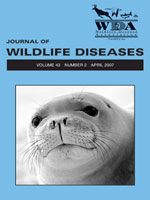Carcasses from 346 raptors found between August 2001 and December 2004 were tested for West Nile virus (WNV) using virus isolation and immunohistochemistry; 40 were positive for WNV by one or both methods. Of these 40 birds, 35 had histologic lesions compatible with WNV infection, one had lesions possibly attributable to WNV, and four had no histologic evidence of WNV. The most common histologic lesions associated with WNV infection were myocardial inflammation, necrosis, and fibrosis; skeletal muscle degeneration, inflammation, and fibrosis; and lymphoplasmacytic encephalitis. Other lesions included hepatitis, lymphoid depletion in spleen and bursa, splenic and hepatic hemosiderosis, pancreatitis, and ganglioneuritis. Gross lesions included calvarial and leptomeningeal hemorrhage, myocardial pallor, and splenomegaly. Red-tailed hawks (Buteo jamaicensis) (10/56), sharp-shinned hawks (Accipiter striatus) (8/40), and Cooper's hawks (Accipiter cooperii) (10/103) were most commonly affected. Also affected were red-shouldered hawks (Buteo lineatus) (2/43), an osprey (Pandion haliaetus) (1/5), barred owls (Strix varia) (4/27), a great horned owl (Bubo virginianus) (1/18), and eastern screech owls (Megascops asio) (4/42). Although birds were examined throughout the year, positive cases occurred only during the summer and late fall (June–December). Yearly WNV mortality rates ranged from 7–15% over the four years of the study. This study indicates trends in infection rates of WNV in raptorial species over a significant time period and supports the available information regarding pathology of WNV infection in Strigiformes and Falconiformes. Although many species tested were positive for WNV infection, severity of lesions varied among species.
How to translate text using browser tools
1 April 2007
PATHOLOGY AND EPIDEMIOLOGY OF NATURAL WEST NILE VIRAL INFECTION OF RAPTORS IN GEORGIA
Angela E. Ellis,
Daniel G. Mead,
Andrew B. Allison,
David E. Stallknecht,
Elizabeth W. Howerth

Journal of Wildlife Diseases
Vol. 43 • No. 2
April 2007
Vol. 43 • No. 2
April 2007
Avian
immunohistochemistry
pathology
raptors
West Nile virus
WNV




